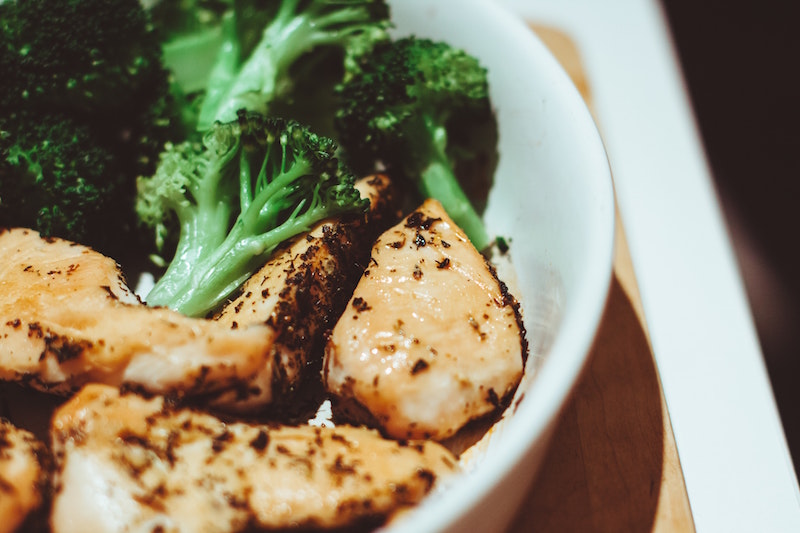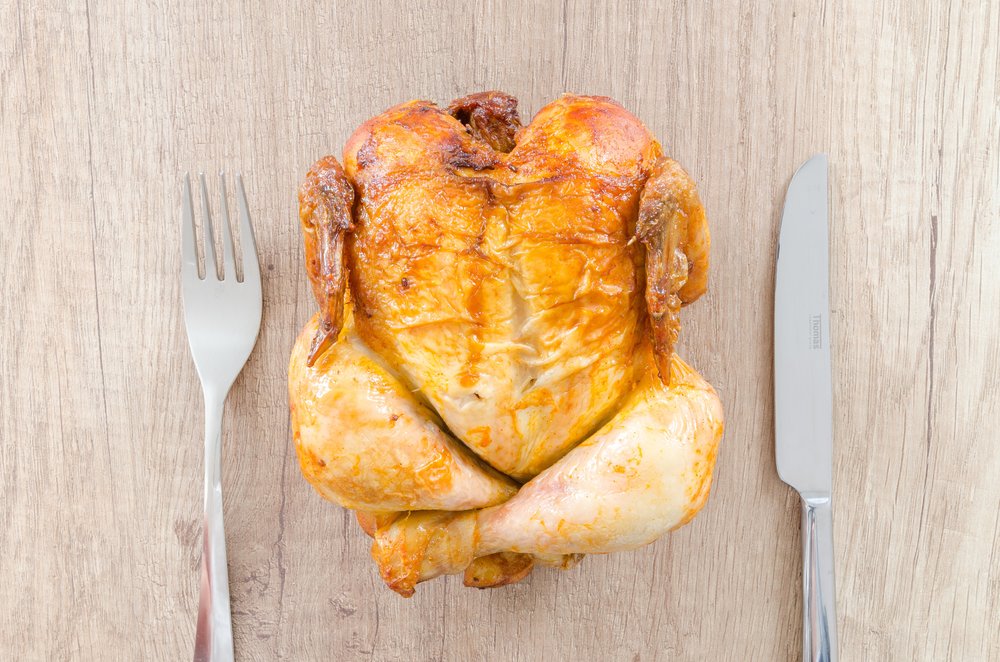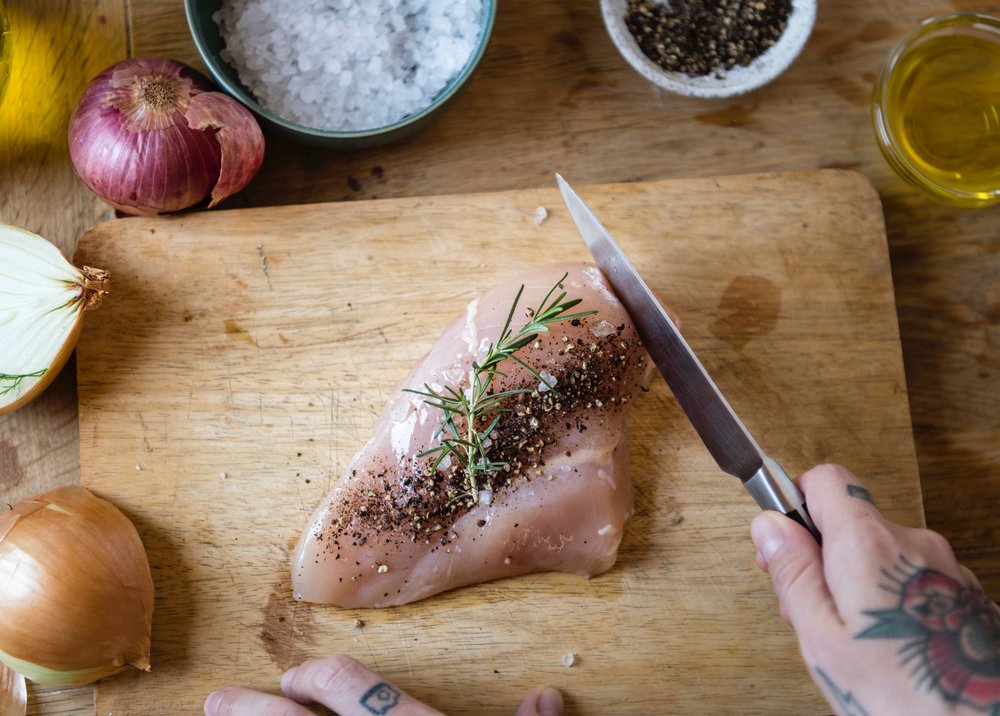
I recently realized I wasn’t getting enough protein.
I’ve been cutting, and seeing good results, but I just felt like something was… holding me back.
So I got to work recalculating all of my macros. And I realized I was coming in on the low end of the low end of protein intake.
And I needed to fix it.
The problem? I was still trying to stay in a calorie deficit and lose weight. I didn’t have room in the diet to add a bunch of new foods in!
So the question was, how could I increase my protein intake without adding calories?
Turns out, the answer is pretty simple:
To increase protein without adding extra calories, you’ll have to eat fewer carbohydrates (and sometimes fat).
Easy, right? Let’s dive in a little deeper on how exactly you can do that, how to calculate how much protein you need, and some really good high protein foods you can swap into your diet.
How much protein do you really need?
How much protein is enough?
It really all depends on your goals.
If you’re just a normal, active person who wants the right amount of protein to stay healthy and maintain your lifestyle and body composition, you’ll need somewhere around .36 grams per pound of bodyweight.
That comes out to somewhere around 50-60 grams per day for an average man, or 40-50 grams per day for an average woman, according to Healthline.
That’s not hard to get. For reference, an average serving of boneless, skinless chicken breast will have around 20-30 grams all by itself.
If you’re very active and like to exercise a lot, you’ll need to eat a bit more to properly fuel your muscles.
If you’re into lifting weights and want to gain muscle or maintain muscle and strength, you should shoot for about .8 to 1 gram of protein per pound of bodyweight.
So for a 160 pound man on a proper strength training program, you should be eating somewhere around 120-160 grams of protein per day for best results.
That’s just a quick example, but you get the idea.
(Psst, check out my absolute favorite workout and nutrition program for getting lean and muscular. I did this program myself and had fantastic results!)
How to eat more protein and less carbs

As I wrote above, the best place to start if you want to eat more protein but not increase your calories, is to think about cutting down on your carb intake.
Your total amount of fat + carbs + protein makes up your total calorie intake.
So if protein goes up, something else must come down!
The reason we’re starting with carbohydrates is because they’re a little easier to isolate in your diet.
(Below, we’ll talk about how reduce fat in your diet. But there just aren’t as many foods that are primarily fat-based to reduce or manipulate in your meal plan. Chances are there are tons of high carb sources that we can adjust.)
What are the biggest sources of carbs and carb-based calories in your diet?
-
Pasta
-
Rice
-
Breads, bagels, tortillas
-
Starchy vegetables (potatoes, corn, sweet potatoes)
-
Fruits
-
Cereal & oatmeal
-
Beer
-
Sugar
-
Beans & legumes
If you’re looking to increase protein and lower carbs, definitely take a look at this list and monitor how much of these foods you’re consuming.
To be 100% clear, I’m not writing that any of these foods are inherently bad or unhealthy for you. In fact, a diet full of carbs from fruits and vegetables will give you plenty of fiber and healthy vitamins and antioxidants.
Carbs in general are really, really important for a body to function properly. They give us energy and allow us to perform at our best. So carbs are not necessarily a bad thing!
But if you’re trying to get more protein in your diet, something has to give.
A couple of starter ideas for you:
-
Eat salads, bowls, and lettuce wraps instead of sandwiches: You’ll save a ton of calories by cutting out the carbs from bread and tortillas this way. You can do this at restaurants, too, which is a bonus. (Order ‘naked’ or ‘bowls’)
-
Cut your pasta portions down: 1 serving of pasta is smaller than you think. If you’re eating a pasta meal, go for fewer noodles and more meatballs, shrimp, or whatever protein you happen to be using.
-
Swap beer for wine or spirits: I love me a good IPA, but they are jam packed with extra calories from carbs. If you’re going to drink, try a glass of red wine or a tumbler of fine whiskey.
-
Watch the sugar: Cutting back on your sugar is a good idea in general, and you’d be surprised how many foods have a bunch of added sugar in them. One good place to start is to take your coffee black or with just milk.
When you start cutting back on carbs via breads, pastas, and other grains, you’ll want to replace those calories with high protein options.
Scroll down for a big list of examples of protein-heavy foods you can swap into your meal plan.
How to eat more protein and less fat
Like I mentioned, fat can be a little bit trickier to isolate in your diet.
Almost everything has some fat in it.
But there are fewer foods that are MOSTLY fat (unlike pasta, bread, and rice which are almost completely carbohydrate based.)
Still, if you want to sneak some more protein into your diet without adding calories, cutting back on your fat intake could be on place to look.
Here are some foods you might be eating that are high in fat:
-
Butter
-
Oils
-
Peanut butter
-
Fried foods
-
Red meat
-
Cheese
-
Whole milk
-
Eggs
-
Yogurt
-
Mayonnaise
Now the hard part about fat is that many of the sources I just listed also happen to be excellent sources of protein.
So if a high protein diet is what you want, cutting out milk, cheese, and eggs probably isn’t the way to go!
But there are a few tweaks you can make to ensure you’re still getting some healthy fats in your diet and bumping up the protein a bit, without adding extra calories:
-
Switch to low fat milk and cheese: With dairy, you can almost always get a skim or low fat version of the same product. In the case of milk, 2% milk has the same amount of protein as a glass of whole milk, just less fat and fewer calories overall. Sometimes, like with cheese, lowering the fat actually makes the protein content go up a smidge.
-
Eat more lean proteins: Enough of the pulled pork and cheeseburgers. Trade them in for lean cuts of chicken and turkey. The protein levels will be just as good, if not better, and you’ll get way less fat and way fewer calories in the end. (Then you can eat more and really boost your protein intake).
-
Go grilled, not fried: This should be a no brainer. If you’re used to eating fried chicken sandwiches, you’re getting a ton of extra calories from fat (and probably carbs from the breading). Switch to grilled chicken and take in a bigger serving for a boost of protein.
-
Watch the condiments: If you’re slathering your food in mayonnaise, creamy sauces, or oils, you’re really adding a lot of unnecessary fat calories. Cut back a little and you’ll make some room for bigger servings of your main protein.
Cut back on your fat intake and replace those calories with some good, low calorie sources of protein.
(My full list is coming up below.)
You don’t have to go “low carb” or “low fat.”
If you just watch your carbs and fat even a little tiny bit, you should easily be able to add 20-30g of protein per day into your diet without altering your calories.
High protein, low calorie food examples

Alright, so you’ve made a little bit of room in your daily calorie total for some more protein.
Maybe you switched from sandwiches to lettuce wraps, or finally kicked your fried food addition.
What are some good, efficient, low calorie and high protein food sources you can work in now?
A few of my personal favorites:
-
Low fat string cheese: The lower fat content keeps the calories down and the protein high. But it’s still delicious and easy to scarf down. The string cheeses I eat are around 80 calories for 7g of protein… Not a bad deal!
-
Greek yogurt: You can get full fat or low fat Greek yogurt and still get a pretty good deal on protein per calorie. I eat Chobani brand Greek yogurts for about 110 calories each and a whopping 13g of protein.
-
Bone broth: If you really want to get serious, drink a hot delicious cup of bone broth. You’ll get a ridiculous 10g of protein for only 40-50 calories, which is the best bargain around, plus all kinds of great minerals and other nutritious goodies. (I like to get these big cases of bone broth from Amazon and keep them around for when I’m in a protein pinch.)
Those options I just listed are really, really low calorie and all pack a pretty solid protein punch. They’re super easy to work into any diet or calorie count and instantly up your overall protein intake.
If you’re looking more for some good protein sources to form meals or other snacks around, you can’t go wrong with:
-
Cod (63g per 290 calories)
-
Tofu (48g per 280 calories)
-
Boneless, skinless chicken breast (33g per 298 calories)
-
Egg whites (4g per 17 calories)
-
Skim milk (8.5g per 90 calories)
If you can just work a few of these into your meal plan, your protein intake will skyrocket without much impact on your calories at all.
Should I use protein shakes to get more protein?
You definitely can. There’s nothing wrong with using a protein shake to get your macros on point.
Personally, I really prefer to eat real food. It tastes better, keeps me fuller, and is a lot more satisfying.
But protein shakes have tons of benefits, including:
-
Convenient
-
Very inexpensive
-
Portable
Cost is probably the best thing about protein shakes.
Eating a ton of lean chicken and dairy can be EXPENSIVE.
So I don’t blame you if you’d rather pound a double scoop of protein powder and just get 60+g right in one sitting.
Just watch out for those protein farts.
Wrapping Up
Let’s recap.
To get more protein in your diet without eating more calories, you have to:
-
Eat less carbs
-
Eat less fat
-
Or both
Your diet could be ballooning with too much bread, pasta, and sugar. Or you could be eating protein sources that are just too high in fat, causing your calories to reach their limit before you’ve gotten enough of the good stuff.
Hopefully the ideas above can help you make the minor tweaks you need.
Remember, you don’t need 400g of protein per day (unless you weigh more than 400 pounds, and probably not even then).
You just need to get anywhere between .36 and 1g of protein per pound of bodyweight, depending on your activity levels and muscle building goals.
With just a few small tweaks to your diet, that should be easily attainable.